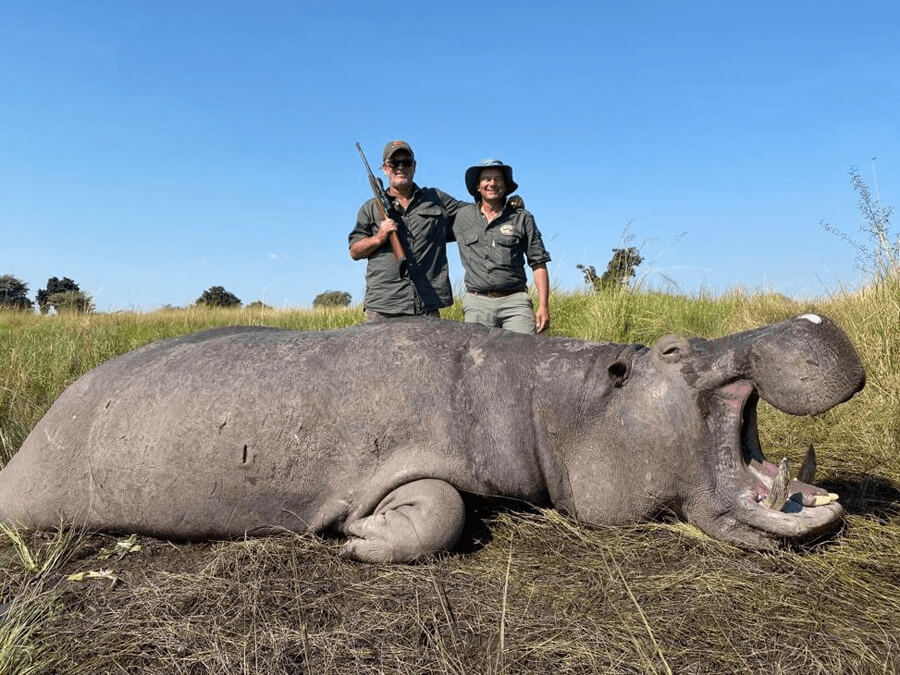Big game hunting in Africa is generally on the minds of all dangerous game hunters who often spend days and months dreaming and planning their African hunts. Completing game hunting goals successfully takes time, dedication, and commitment.
An African hunting trip is often on the top of any hunter’s list as African hunts and destinations are generally more affordable than hunting in the USA or on other continents, and they also offer a wider variety of big game hunting, with Big 5 hunting or hunting the Dangerous 7 being exceptionally popular. Big game hunting in Africa remains challenging and continually pushes the hunters to their limits, whether in terms of endurance or the perfect shot placement to ensure success in harvesting the much sought-after trophy.
[DYNAMIC-BLOGTABLEOFCONTENT]
Namibia as a Hunting Destination
Namibia is quickly becoming one of the top big game hunting destinations worldwide. When compared to hunting in South Africa, Namibia is 97% the size, with a population of roughly only three million people, compared to the sixty million in South Africa.
The Namibian landscape consists of five geographical areas:
- The Namib Desert in the west
- The Great Escarpment
- The Central Plateau
- The Kalahari basin in the east
- The Kavango-Caprivi Region
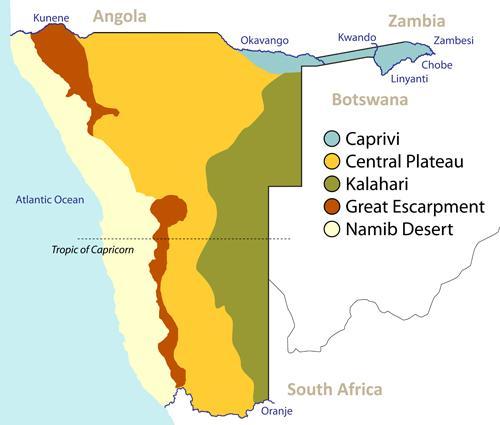
Namib Desert
The Namib Desert is a broad expanse of gravel without moisture, plains, and dunes and stretches the entire coastline. Little to no vegetation can survive the harsh conditions, except for lichens found in the gravel plains and dry riverbeds, where plants can access subterranean water.
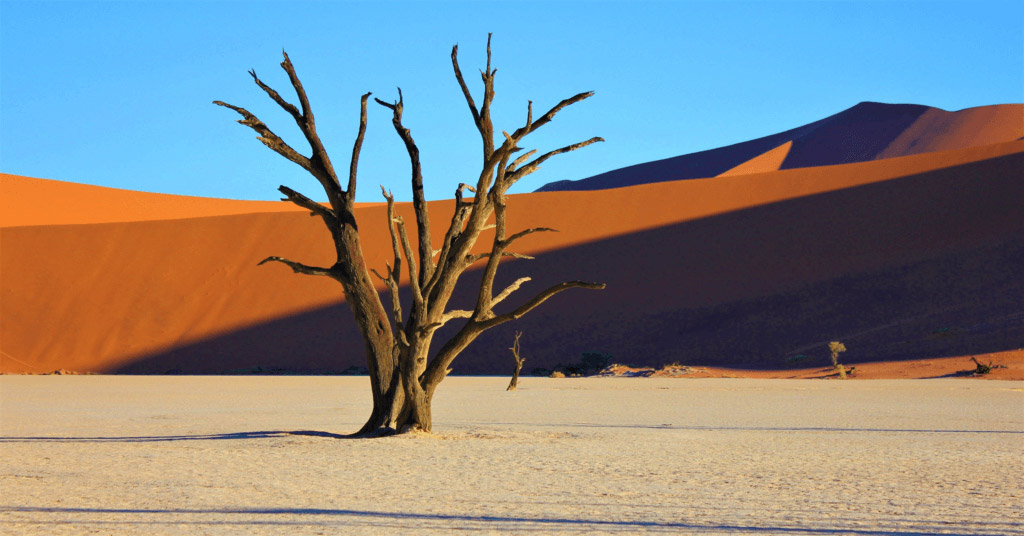
Great Escarpment
Central Plateau
Kalahari Basin
The Kavango-Caprivi Region
The Kavango-Caprivi area with its sub-tropical temperatures forms a separate natural region in the otherwise arid Namibia. This area is renowned for elephant hunting, with some big tuskers occupying these territories and even bigger trophies available in the northern regions. There is nothing quite like elephant hunting in Namibia, with buffalo, lion, and leopard readily available to complete your big game hunting experience. Hippos and crocodiles are plentiful in the Caprivi Strip, making it a hunter’s dream destination.
About The Hippo
- There are two species of hippos, the large/common hippo and the smaller pygmy hippo.
- Hippos are the third-largest living land mammal, after elephants and the white rhino, and are members of the dangerous seven for obvious reasons.
- They have four-webbed toes that splay out to distribute weight evenly and support them on land.
- They have exceptionally thick skin (except on the belly) that is virtually hairless but helps protect them during fighting.
- They use their flat paddle-like tail to spread excrement that marks territories and borders.
- Large males can reach a weight of nearly six thousand pounds and have tusks of one and a half feet.
- Their jaws can open to nearly one hundred and sixty degrees.
- The hippo is considered extremely aggressive and is known to charge people and boats.
- These herbivores spend most of their days in water to cool and stay hydrated and live in estuaries, swamps, and river channels in Africa.
- It is estimated that hippos kill more than five hundred people every year. They kill more people than lions, elephants, buffalos, and rhinos combined!
- You cannot outrun a hippo. Hippos may look sluggish but can reach speeds of almost 30 mph.
- Suggestion: Ensure that your shot placement is perfect.
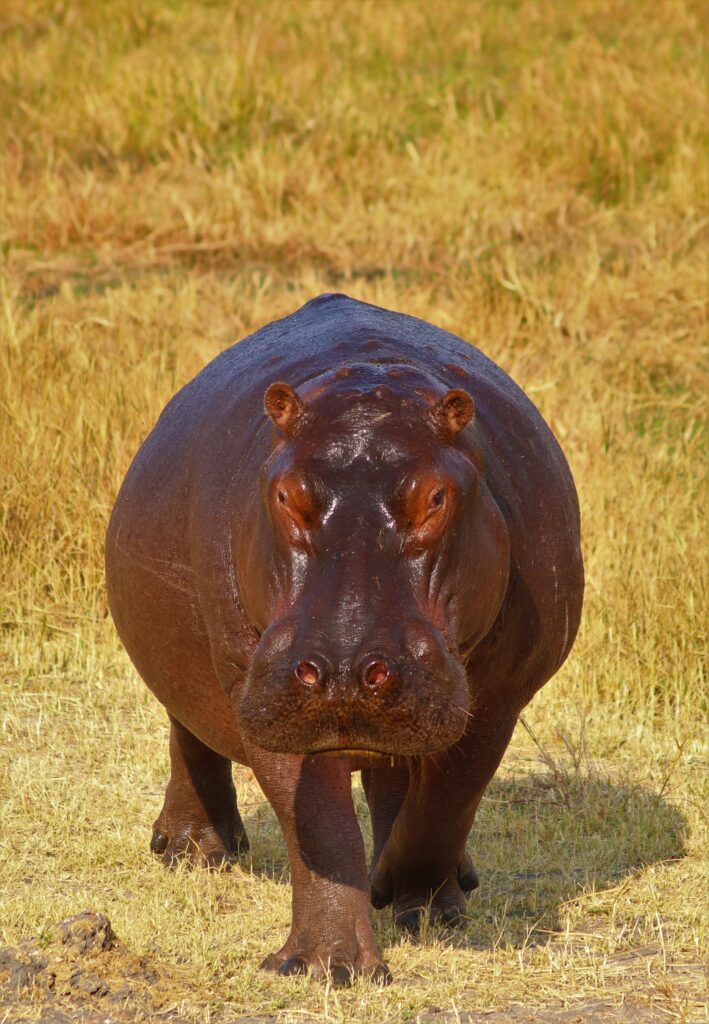
Hippo Hunting in Namibia
Lying in a hospital bed recovering from a spinal fusion operation, worst of all with a catheter in place, that I can assure you was not at all pleasant, I knew I was losing my mind at a rapid rate. The thought of leaving the hospital and spending two months in bed nearly pushed me over the edge.
I did the only thing I could do with the internet being my best friend….research! Upon completion of my research, I booked a game hunting safari to maintain what little sanity I had left! African big game hunting is a passion, and feeling obese just lying there like a dead man, hunting a hippo in the Caprivi Strip sounded like a great idea as it felt as if I could certainly relate. It was a motivation to get up and start putting in hours of walking.
I chatted with a few outfitters I knew, and before I knew it, we had booked a big game hunting adventure to Namibia.
Travelling to the Hunting Safari Lodge
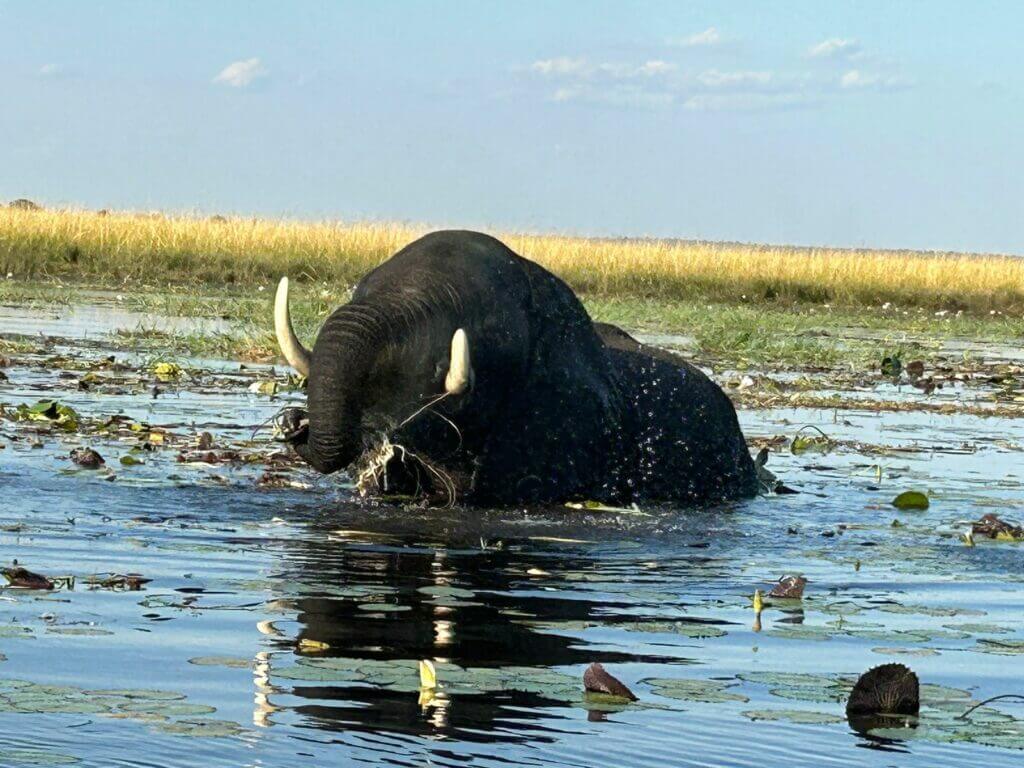
A few weeks earlier the outfitter called and asked if I did not want to move the dates as after all the rain in the area, the Caprivi had flooded, but we chose to push through as we had other commitments. This decision I later learned, made big game hunting far more of a challenge.
The sheer number of elephants in the Chobe Reserve, which is literally on the other side of the river from Namibia, is ridiculous, and the numbers climbed exponentially when the Government banned hunting in 2014. More than 50,000 elephants in an area of roughly 250,000 acres, crazy stuff! From a wildlife conservation perspective, it is heartbreaking to see what havoc the overpopulation of elephants is doing to the environment and how the resident sables, kudu, and other plains game are negatively affected.
In 2019 the Botswanan Government opened the elephant hunting industry again and issued 300 tags per year. Unfortunately, not nearly close to the required number. Maybe we can look forward to a few discounted hunts in the up-and-coming years.
Maneuvering our little canoe through the shallows, we arrived in a little “harbor.” After a short walk, we arrived at the lodge. The lodge was perfect in every way. The camp team members were super friendly and welcoming. The bar and dining area were fully equipped, with the deck offering beautiful African views over the Caprivi Strip. The tented accommodation was clean and spacious, with plenty of hot water. No matter what time of the day you walked into your suite, there was ice-cold water at your disposal! I do not think my hunting gear has ever been cleaned so well.
My favorite team member – if I were forced to choose one – was Maria, the chef. The only complaint I could make was that the food was too good and too much. One cannot say no to all these delicacies, and after a few days, I was feeling as much as looking like one of the local hippos.
In this area of Namibia, big game hunting mostly focused on crocodiles, buffalo, elephants, and hippos. The camp lodge was perfectly decorated with many buffalo, hippo, and elephant skulls.
Shot Placement on a Hippo
Shot placement largely depends on where you find your target hippo. I learned the hard way that finding one on land, which was my plan when booking the safari hunting trip, would be almost impossible. In water, should you find a lone bull or spot one in a pod, it can only be the headshot. Straight between the eyes or from the side, between the eye and ear, a target of roughly two inches.
It is very difficult to judge the size of a hippo when just his snout and beady little eyes are glaring at you from in the water. On land, an option would be to take him about a third of the way up in the middle of the front leg. This will blow his heart apart. You do not want him wounded and then charging or heading for the water. The other option, of course, is a neck shot that will sever the spine.
When the PH told me it would probably be a headshot, my heart missed a few beats, as I had mentally planned to take him on land at about thirty yards. Well, that was the plan, at least. But, like with most African hunts, you need to be able to adapt at short notice.
Rifles, Calibers and Ammunition
Like with all big game animals, a .375 is a minimum legal requirement and was supplied to us by the outfitter. A H & H magnum, perfect for the upcoming job at hand. It gets quite tricky when trying to decide because if you are presented with a headshot 40 yards or more, a high-powered, accurate rifle, with plenty of muzzle energy, is required to penetrate the thick bone of the skull. Accuracy is critical for the brain kill shot. If the hippo is on land, I would prefer something bigger that packs plenty of punch, like a .458 and upwards.
The Hippo Hunt
Hippo Hunting Safari in Namibia: Day One
Hunting in Namibia is challenging at the best of times. No fences, with land and waterways stretching as far as the eye can see. Climbing into our little canoe, we headed off on day one through the rivers and estuaries in search of a trophy bull. Hunting is an absolute privilege, with nothing matching the excitement of searching for African big game animals.
The rivers and banks were teaming with big, old, prehistoric Nile crocodiles, and plenty of elephants, and the Cape buffalo were beginning to cross the Chobe River and head north. When hunting hippos, the challenges and dangers are real, not only from hippos and other African Big Five animals but also from snakes.
Representatives of the Namibian government accompanied the hunt to ensure that there weren’t any international laws breached. We spotted a few hippo pods and some lone bulls that, unfortunately, always seemed to be on the Botswanan side of the Chobe River. With the Caprivi Strip being such a narrow expanse of land, the local Namibian government officials constantly reminded you which side was Namibia, Botswana, or Zambia. It was as if all the hippos knew they were safe in the neighboring countries, literally 30 to 50 yards away from us.
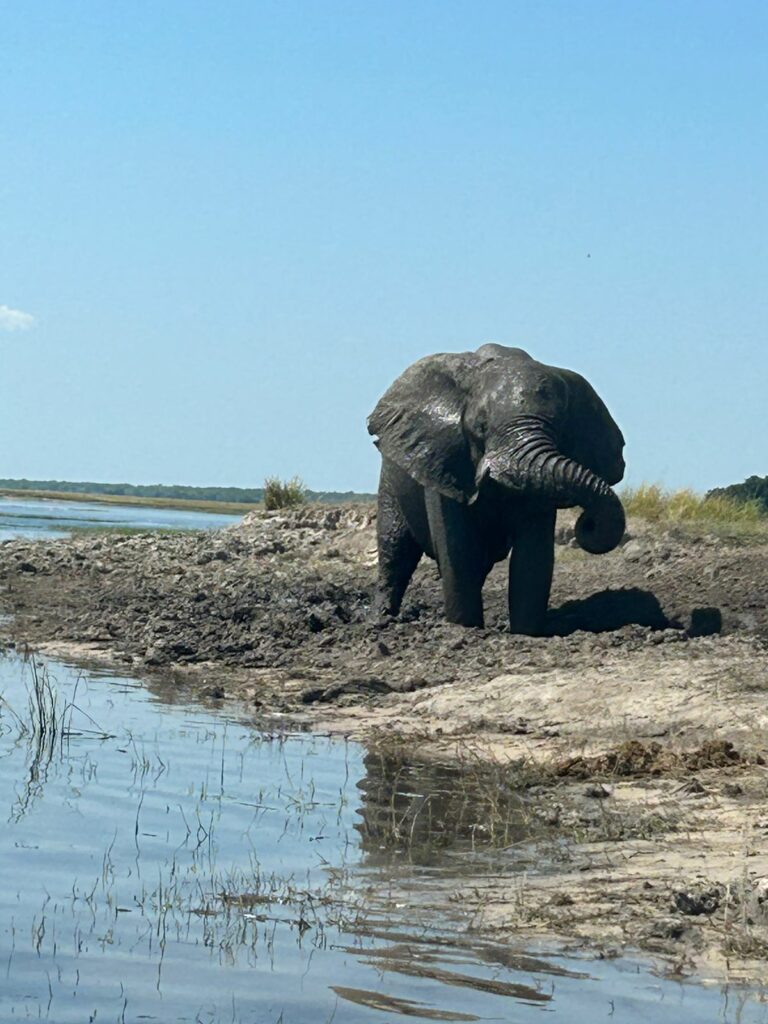
After lunch, we headed back out in the blazing sun and stumbled across a lone bull lurking next to the shoreline in the reeds in some deep water. At about a hundred yards out, the hippo sank back into the water and disappeared. Knowing an adult hippo can hold his breath, we waited to see where he would pop out. The problem was that we were still in the canoe, and there was no way I could take a shot off the water. It just was not a consideration when I remembered the accuracy required for a brain shot. As luck would have it, he surfaced about 50 yards away. Those beady eyes seemed to be chuckling as if he knew he was now in Botswana. This was getting frustrating, and I had to remind myself that it was only day one of the hunting adventure.
As the African sun set behind us, we headed to camp, to Maria and a range of cold beverages.
Maria, no hippo today!
Hippo Hunting Safari in Namibia: Day Two
Up early after another fine early morning breakfast, we headed back out into the Caprivi. African hunts require a quality, wide-brimmed hat, plenty of water, and a pair of good binoculars. The little canoes are narrow, and it feels as if they will tip over with any sudden movement. The crocodiles always seemed to be watching and waiting for this to happen and for their next meal to be delivered courtesy of the Chobe River.
We spotted a bull hippo a few hours later, who, for once, seemed to be unaware that he was in Namibia. Great news indeed. We continued about five hundred yards up the channel and moored the canoe. We made our way slowly to a vantage point opposite his lair and lay to see how we could make this happen. The hippo was not unaware of our presence. He was about a hundred across the channel, a little too far for my liking. Tamlyn, on the other hand, seemed more concerned that we might be ambushed by a crocodile from behind and become a snack!
A few hours later, with the hippo not budging and me not keen on the shot, we again packed up and headed back to the safari lodge.
Maria, no hippo today!
Hippo Hunting Safari in Namibia: Day Three
On day three, we decided to change our strategy. We walked the banks hoping to “spook” up a bull. Dragging yourself through the thick reeds and crocodile-infested waters, ankle and or waist deep, makes you wonder who the prey is! We ended up bumping into a hippo cow and her calf and slowly backed away to relative safely.
That afternoon we tried another strategy and dragged the canoe through the papyrus reeds, which was a challenge. Minimal visibility and plenty of predators. We spooked up a bull and began to follow his spoor. I use that term loosely because it looked as if a tanker had flattened the area ahead of us. The only sound is your heart pumping in your chest and the sound of the canoe through the reeds. This is big game hunting in Africa at its best.
Out of nowhere, a crocodile leaped out and bumped into the side of our canoe. Tamlyn could have reached out and touched him with minimal effort. Tamlyn seemed to be having many, “Oh my %^%&&^” moments as she called them out here in the Caprivi. Our PH advised that it is imperative that you have at least 30 minutes a day of these moments to keep the blood flowing and the adrenaline pumping! It increases one’s life span.
Continuing the search, it looked as if that bull hippo had vanished into the abyss.
Maria, no hippo today.
That night around the campfire we had some intense discussions regarding the best strategy to employ. The vast amount of water made it impossible to get a hippo on land, and it was as if all the hippos had just renewed their Botswanan passports.
Hippo Hunting Safari in Namibia: Day Four
We headed out early, with the weather perfect as usual. We started chatting to a few local fishermen to see if they had spotted anything. Nothing!
We decided to take a trip to the south and skirted the Chobe reserve borders. The elephants, as usual, were plentiful. We spotted a few monsters old “dagga boys.” Nothing like seeing Africa’s Black Death up close and personal, glaring at you from its mud pools. All Cape buffalo seem to be born with the intent of killing hunters.
We decided to head back to camp for lunch. It was hot on the water. Up ahead we spotted a bull hippo about a hundred yards out, half submerged in the water and near a steep embankment. I just knew this was my hippo. We pulled up the canoe, and I dashed to the side of the embankment. The rest of the hunting crew decided to stay in the canoe so as not to spook him. Lying at a sideway angle, I gave him a quick look through the scope. He was a monster of a trophy but began backing up into deeper water. He turned sideways, and I had the perfect kill shot between the eyes and ear. Nerves and adrenaline were at full tilt, and my aim seemed to be moved all over that monstrous head.
I did not take the shot, and I knew that I had missed my opportunity. Buck fever can be a terrible thing. I glanced at the canoe and saw the rest of the hunting team sitting, hands covering their ears.
Looking back at that old bull, he seemed to launch himself out of the water and opened his jaw showing enormous ivory tusks. A crocodile moved further up the river, and the hippo turned to look. That was his mistake. I saw the mark and squeezed the shot. He just sank into the deep water along with my heart, not making a sound.
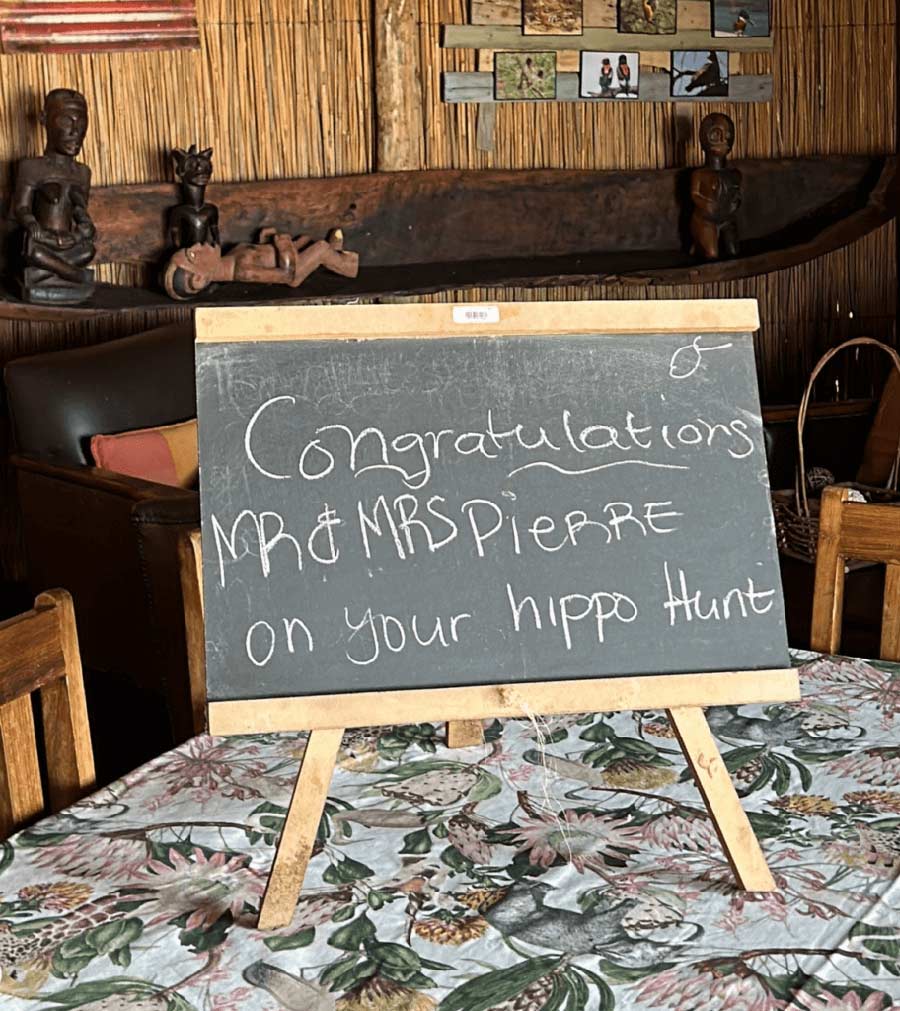
Getting back to the canoe everyone was cheering. I was not convinced. I needed to see him. We backed off into some reeds and decided to wait. It can take anything from two hours to five hours for a hippo to begin to float to the surface. The hunting crew wanted to return to camp for lunch and wait for him to surface. I flatly refused.
We waited in the heat for a couple of hours. I said to the PH that if we did not take a look and see if he had surfaced, I would consider swimming in these crocodile-infested waters to see for myself! My nerves were shot. As we had seen no movement up or down the river since taking the shot, which was many hours past, we took a slow paddle across. One of the guides pointed down and smiled. There was the tank about two meters under.
Maria, we got a hippo!
Seems like the bush telegraph moves quicker than a charging buffalo. We were met with champagne on ice, together with a huge chalkboard with words of congratulations. This outfitter was certainly on top of his game!
Recovering an African Hippo
This in itself was a challenge. We tied a foot to the canoe and slowly made our way back to camp. It took approximately thirty members of the local tribe folk, who came running from every direction, to recover him from the water and roll onto the bank. Fires were burning all over the Caprivi, and there would be a feast with hippo on the menu! Looking at the sheer size of the animal the first thought I had, was that I should have used more guns. Tamlyn commented, “You did not just complete a successful hippo hunt, but you have fed an entire community. We can be proud of what we have achieved.” It turns out that it had been five months since the residents had last tasted red meat.
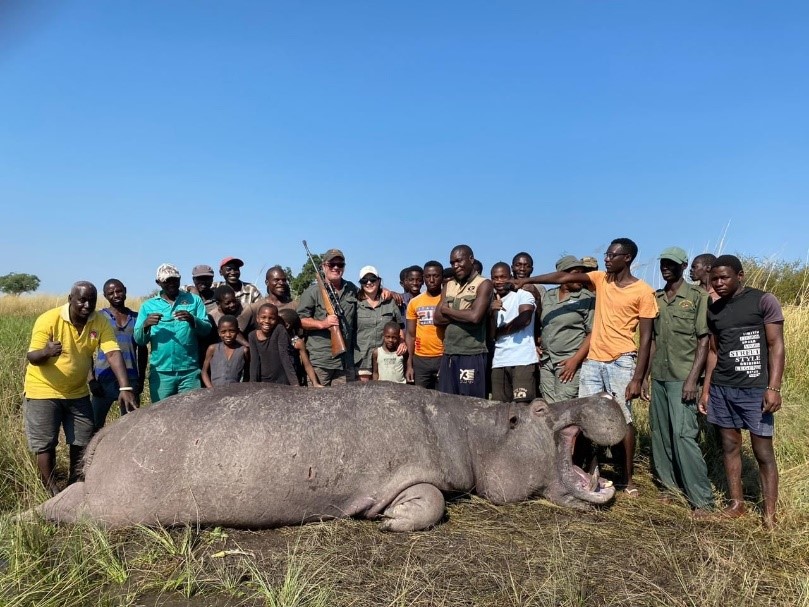
Having a closer look at that enormous head, I could not find the entry hole of the 300-grain bullet. I had pulled the shot and had severed the spinal cord. The Lord works in mysterious ways.
Watching the locals armed with knives and axes reminded me of watching the start of a motocross race with all participants revving away and waiting for the start bell to go off. In this case, it was for the skilled skinners to complete the capping process so that the butchering and processing could begin.
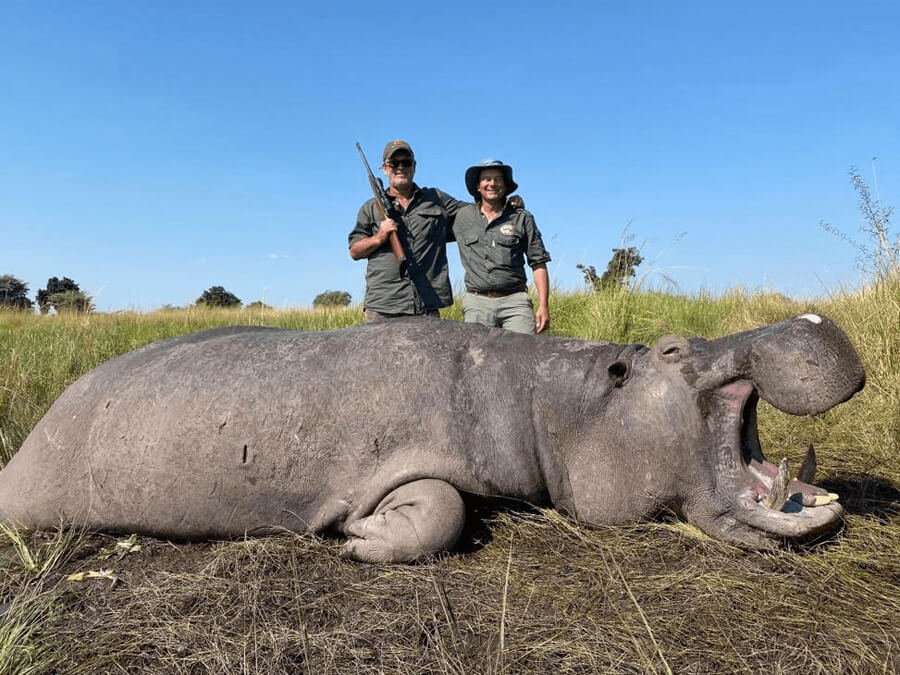
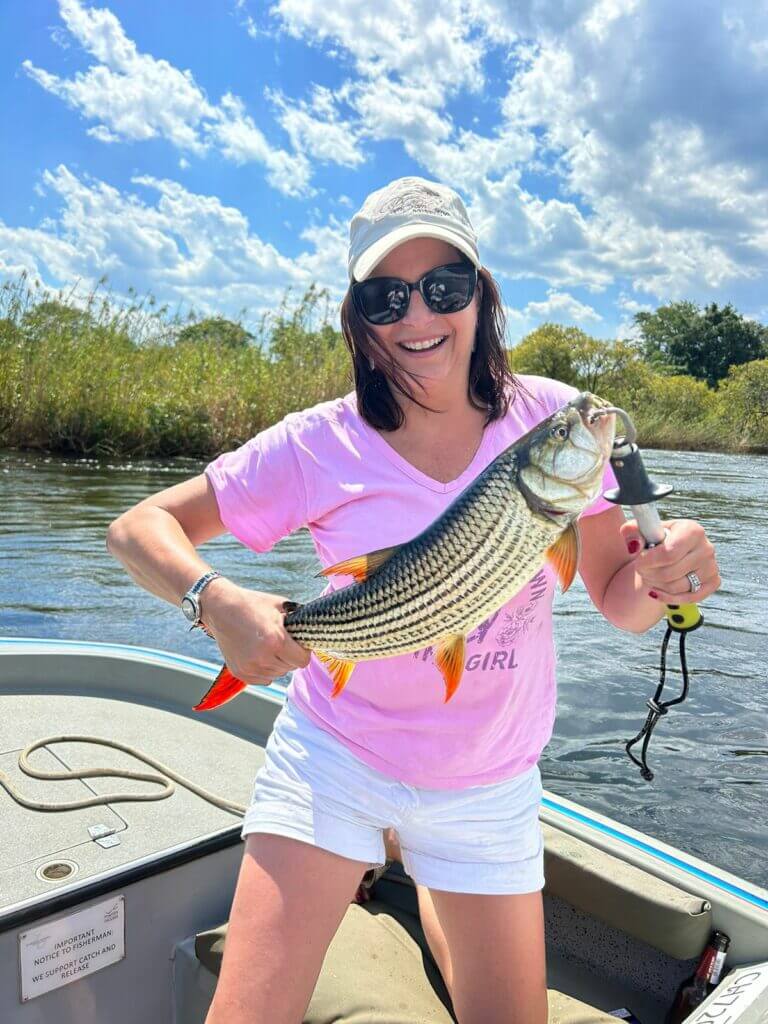
What’s Your Perfect Hunting Adventure?
When big game hunting in Africa, on a hunting safari in Namibia, not many other experiences are equally matched. When booking a hunting adventure and the focus is going to be on a hippo, should you be in a position to afford it, always check with us if you can also secure a crocodile tag. There are plenty of old dinosaurs sharing the same habitat.
Tiger fishing is also readily available depending on the season and water levels, and is great way to unwind after an exciting African hunt.
Contact us for more details about hippo, crocodile or Dangerous 7 hunting safaris.
Author: Pierre van Wyk
